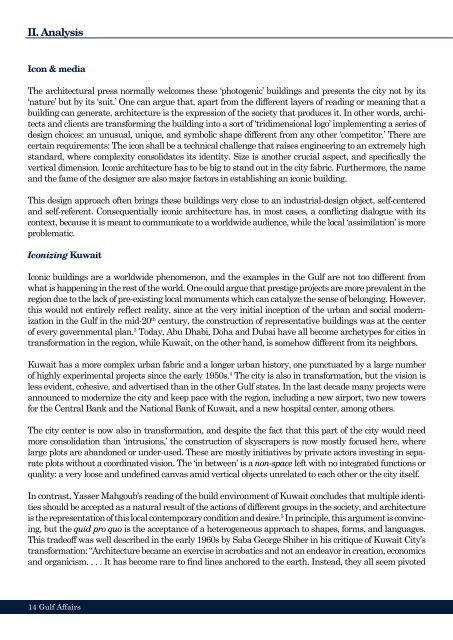You also want an ePaper? Increase the reach of your titles
YUMPU automatically turns print PDFs into web optimized ePapers that Google loves.
II. Analysis<br />
Icon & media<br />
The architectural press normally welcomes these ‘photogenic’ buildings and presents the city not by its<br />
‘nature’ but by its ‘suit.’ One can argue that, apart from the different layers of reading or meaning that a<br />
building can generate, architecture is the expression of the society that produces it. In other words, architects<br />
and clients are transforming the building into a sort of ‘tridimensional logo’ implementing a series of<br />
design choices: an unusual, unique, and symbolic shape different from any other ‘competitor.’ There are<br />
certain requirements: The icon shall be a technical challenge that raises engineering to an extremely high<br />
standard, where complexity consolidates its identity. Size is another crucial aspect, and specifically the<br />
vertical dimension. Iconic architecture has to be big to stand out in the city fabric. Furthermore, the name<br />
and the fame of the designer are also major factors in establishing an iconic building.<br />
This design approach often brings these buildings very close to an industrial-design object, self-centered<br />
and self-referent. Consequentially iconic architecture has, in most cases, a conflicting dialogue with its<br />
context, because it is meant to communicate to a worldwide audience, while the local ‘assimilation’ is more<br />
problematic.<br />
Iconizing Kuwait<br />
Iconic buildings are a worldwide phenomenon, and the examples in the Gulf are not too different from<br />
what is happening in the rest of the world. One could argue that prestige projects are more prevalent in the<br />
region due to the lack of pre-existing local monuments which can catalyze the sense of belonging. However,<br />
this would not entirely reflect reality, since at the very initial inception of the urban and social modernization<br />
in the Gulf in the mid-20 th century, the construction of representative buildings was at the center<br />
of every governmental plan. 3 Today, Abu Dhabi, Doha and Dubai have all become archetypes for cities in<br />
transformation in the region, while Kuwait, on the other hand, is somehow different from its neighbors.<br />
Kuwait has a more complex urban fabric and a longer urban history, one punctuated by a large number<br />
of highly experimental projects since the early 1950s. 4 The city is also in transformation, but the vision is<br />
less evident, cohesive, and advertised than in the other Gulf states. In the last decade many projects were<br />
announced to modernize the city and keep pace with the region, including a new airport, two new towers<br />
for the Central Bank and the National Bank of Kuwait, and a new hospital center, among others.<br />
The city center is now also in transformation, and despite the fact that this part of the city would need<br />
more consolidation than ‘intrusions,’ the construction of skyscrapers is now mostly focused here, where<br />
large plots are abandoned or under-used. These are mostly initiatives by private actors investing in separate<br />
plots without a coordinated vision. The ‘in between’ is a non-space left with no integrated functions or<br />
quality: a very loose and undefined canvas amid vertical objects unrelated to each other or the city itself.<br />
In contrast, Yasser Mahgoub’s reading of the build environment of Kuwait concludes that multiple identities<br />
should be accepted as a natural result of the actions of different groups in the society, and architecture<br />
is the representation of this local contemporary condition and desire. 5 In principle, this argument is convincing,<br />
but the quid pro quo is the acceptance of a heterogeneous approach to shapes, forms, and languages.<br />
This tradeoff was well described in the early 1960s by Saba George Shiber in his critique of Kuwait City’s<br />
transformation: “Architecture became an exercise in acrobatics and not an endeavor in creation, economics<br />
and organicism. . . . It has become rare to find lines anchored to the earth. Instead, they all seem pivoted<br />
14 Gulf Affairs


